Lou Gehrig
| Lou Gehrig | ||
|---|---|---|
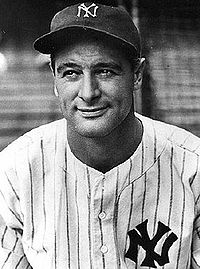 |
||
| First baseman | ||
| Born: June 19, 1903 New York, New York |
||
| Died: June 2, 1941 (aged 37) Riverdale, Bronx |
||
| Batted: Left | Threw: Left | |
| MLB debut | ||
| June 15, 1923 for the New York Yankees |
||
| Final game | ||
| April 30, 1939 for the New York Yankees |
||
| Career statistics | ||
| Batting average | .340 | |
| Home runs | 493 | |
| Runs batted in | 1,995 | |
| Teams | ||
|
||
| Career highlights and awards | ||
|
||
| Member of the National |
||
| Elected | 1939 | |
| Vote | Unanimous | |
Henry Louis "Lou" Gehrig (June 19, 1903 – June 2, 1941), born Ludwig Heinrich Gehrig,[1] was an American baseball player in the 1920s and 1930s, chiefly remembered for his prowess as a hitter and the longevity of his consecutive games played record, which stood for more than a half-century, and the pathos of his tearful farewell from baseball at age 36, when he was stricken with a fatal disease. Popularly called "The Iron Horse" for his durability, Gehrig set several Major League records.[1] His record for most career grand slams (23) still stands as of 2008.[2] Gehrig was voted the greatest first baseman of all time by the Baseball Writers' Association.[3] Gehrig was the leading vote-getter on the Major League Baseball All-Century Team, chosen by fans in 1999.[4]
A native of New York City, he played for the New York Yankees until his career was cut short by amyotrophic lateral sclerosis (ALS), now commonly referred to in the United States as Lou Gehrig's Disease.[5] Over a 15-season span between 1925 and 1939, he played in 2,130 consecutive games. The streak ended when Gehrig became disabled with the fatal neuromuscular disease that claimed his life two years later. His streak, long believed to be one of baseball's few unbreakable records, stood for 56 years until finally broken by Cal Ripken, Jr., of the Baltimore Orioles on September 6, 1995.
Gehrig accumulated 1,995 runs batted in (RBI) in seventeen seasons with a lifetime batting average of .340, a lifetime on-base percentage of .447, and a lifetime slugging percentage of .632. A seven-time All-Star (the first All-Star game was not until 1933; he did not play in the 1939 game, retiring a week before it was held — at Yankee Stadium[6]), he won the American League's Most Valuable Player award in 1927 and 1936 and was a Triple Crown winner in 1934, leading the American League in batting average, home runs, and RBIs.[7]
Contents |
Early life
Gehrig was born in the Yorkville section of Manhattan, weighing almost 14 pounds (6.4 kg) at birth, the son of poor German immigrants Heinrich Gehrig and Christina Fack.[7] His father was a sheet metal worker by trade, but frequently unemployed due to ill health, so his mother was the breadwinner and disciplinarian.[8] Both parents considered baseball to be a schoolyard game; his domineering mother steered young Lou toward a career in business.[8]
Lou Gehrig went to PS 132 in the Washington Heights section of Manhattan and then to Commerce High School, graduating in 1921.[9][10] Gehrig then studied at Columbia University for two years, although he did not graduate.[11] While attending Columbia, he was a member of Phi Delta Theta fraternity.[12] Initially, Gehrig could not play intercollegiate baseball for the Columbia Lions because he had played baseball for a summer professional league during his freshman year.[12] At the time, he was unaware that doing so jeopardized his eligibility to play any collegiate sport. Gehrig was ruled eligible to play on the Lions' football team and was a standout fullback. He later gained baseball eligibility and joined the Lions on that squad as well.
Gehrig first garnered national attention for his baseball ability while playing in a game at Cubs Park (now Wrigley Field) on June 26, 1920. Gehrig's New York School of Commerce team was playing a team from Chicago's Lane Tech High School, in front of a crowd of more than 10,000 spectators.[13] With his team winning 8-6 in the top of the ninth inning, Gehrig hit a grand slam completely out of the Major League ballpark, an unheard-of feat for a 17-year old high school boy.[13][14]
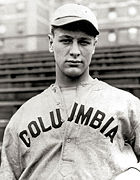
On April 18, 1923, the same day that Yankee Stadium opened for the first time and Babe Ruth inaugurated the new stadium with a home run, Columbia pitcher Gehrig struck out seventeen Williams batters for a team record. However, Columbia lost the game. Only a handful of collegians were at South Field that day, but more significant was the presence of Yankee scout Paul Krichell, who had been trailing Gehrig for some time. It was not Gehrig’s pitching that particularly impressed him. Instead, it was Gehrig’s powerful left-handed hitting. During the time Krichell had been observing the young Columbia ballplayer, Gehrig had hit some of the longest home runs ever seen on various Eastern campuses, including a 450-foot (137 m) home run on April 28 at Columbia's South Field which landed at 116th Street and Broadway.[15] Within two months, Gehrig had signed a Yankee contract.[12]
Major League Baseball career
Gehrig joined the New York Yankees midway through the 1923 season and made his debut on June 15 1923, as a pinch hitter. In his first two seasons, he saw limited playing time, mostly as a pinch hitter — he played in only 23 games and was not on the Yankees' 1923 World Series roster. In 1925, he batted 437 times for a respectable .295 batting average with 20 home runs and 68 runs batted in (RBIs).[16]
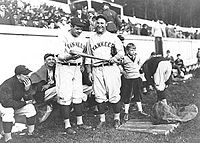
The twenty-three year old Yankee first baseman's breakout season came in 1926, when he batted .313 with 47 doubles, an American League leading 20 triples, 16 home runs, and 112 RBIs.[16] In the 1926 World Series against the St. Louis Cardinals, Gehrig hit .348 with two doubles and 4 RBIs. The Cardinals won a seven-game series, winning four games to three.[17]
In 1927, Gehrig put up one of the greatest seasons by any batter in history. That year, he hit .373, with 218 hits: 52 doubles, 18 triples, 47 home runs, 175 runs batted in, and a .765 slugging percentage.[16] His 117 extra-base hits that season are second all-time to Babe Ruth’s 119 extra base hits in 1921[16] and his 447 total bases are third all-time to Babe Ruth's 457 total bases in 1921 and Rogers Hornsby's 450 in 1922.[16] Gehrig's great season helped the 1927 Yankees to a 110-44 record, the AL pennant, and a four-game sweep over the Pittsburgh Pirates in the 1927 World Series. Although the AL recognized his season by naming him league MVP, his season was overshadowed by Babe Ruth’s 60 home run season and the overall dominance of the 1927 Yankees, a team often cited as having the greatest lineup of all time — the famed Murderers' Row.[18]
Despite playing in the shadow of the larger-than-life Ruth for two-thirds of his career, Gehrig was one of the highest run producers in baseball history: he had 509 RBIs during a three-season stretch (1930-32). Only two other players, Jimmie Foxx with 507 and Hank Greenberg with 503, have surpassed 500 RBIs in any three seasons; their totals were non-consecutive. (Babe Ruth had 498.)[19] Playing fourteen complete seasons, Gehrig had thirteen consecutive seasons with 100 or better RBIs (a Major League record he shares with Jimmie Foxx). Gehrig had six seasons where he batted .350 or better (with a high of .379 in 1930), plus a seventh season at .349. He had eight seasons with 150 or more RBIs, 11 seasons with over 100 walks, eight seasons with 200 or more hits, and five seasons with more than 40 home runs.[20] Gehrig led the American League in runs scored four times, home runs three times, and RBIs five times. His 184 RBIs in 1931 is still an American League record as of 2008 and second all-time to Hack Wilson's 191 RBIs in 1930. Three of the top six RBI seasons in baseball history belong to Gehrig. He also holds the baseball record for most seasons with 400 total bases or more, accomplishing this feat five times in his career.[20]
During the ten seasons (1925-1934) in which Gehrig and Ruth were both Yankees and played a majority of games, Gehrig had more home runs than Ruth only once, in 1934, when he hit 49 compared to Ruth’s 22 (Ruth played 125 games that year). They tied at 46 in 1931. Ruth had 424 home runs compared to Gehrig’s 347. Gehrig had more RBIs in seven years (1925, 1927, 1930-1934) and they tied in 1928. Ruth had 1,316 RBIs compared to Gehrig’s 1,436, although the latter had more hits in eight years (1925, 1927-28, 1930-34) and a higher slugging percentage in two years (1933-34). Gehrig also had a higher batting average in seven years (1925, 1927-28, 1930, 1932-34). For that span, Gehrig had a .343 batting average, compared to .338 for Ruth.[21]
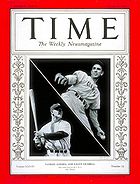
In 1932, Gehrig became the first player of the 20th century to hit four home runs in a single game, accomplishing the feat on June 3 against the Philadelphia Athletics.[22] He narrowly missed getting a fifth home run in the game when Athletics center fielder Al Simmons made a leaping catch of another Gehrig-hit fly ball at the centerfield fence. After the game, Manager Joe McCarthy told him, "Well, Lou, nobody can take today away from you..." However, on that same day, John McGraw chose to announce his retirement after 30 years of managing the New York Giants, and so McGraw, not Gehrig, got the headlines in the sports sections the next day and Gehrig, as usual, was overshadowed.[23] The following year, in September 1933, Gehrig married Eleanor Twitchell, the daughter of Chicago Parks Commissioner Frank Twitchell.[16]
In a 1936 World Series cover story about Lou Gehrig and Carl Hubbell, Time magazine proclaimed Gehrig "the game's No. 1 batsman", who "takes boyish pride in banging a baseball as far, and running around the bases as quickly, as possible".[24]
2,130 consecutive games
On June 1, 1925, Gehrig entered the game as a pinch hitter, substituting for shortstop Paul "Pee Wee" Wanninger. The next day, June 2, Yankee manager Miller Huggins started Gehrig in place of regular first baseman Wally Pipp. Pipp was in a slump, as were the Yankees as a team, so Huggins made several lineup changes to boost their performance. Fourteen years later, Gehrig had played 2,130 consecutive games. In a few instances, Gehrig managed to keep the streak intact through pinch hitting appearances and fortuitous timing; in others, the streak continued despite injuries. For example:
- On April 23, 1933, an errant pitch by Washington Senators hurler struck Gehrig in the head. Although almost knocked unconscious, Gehrig recovered and remained in the game.
- On June 14, 1933, Gehrig was ejected from a game, along with manager Joe McCarthy, but he had already been at bat, so he got credit for playing the game.
- On July 13, 1934, Gehrig suffered a "lumbago attack" and had to be assisted off the field. In the next day's away game, he was listed in the lineup as "shortstop", batting lead-off. In his first and only plate appearance, he singled and was promptly replaced by a pinch runner to rest his throbbing back, never taking the field. A&E's Biography speculated that this illness, which he also described as "a cold in his back", might have been the first symptom of his debilitating disease.[25]
In addition, X-rays taken late in his life disclosed that Gehrig had sustained several fractures during his playing career, although he remained in the lineup despite those previously undisclosed injuries.[26] Gehrig's record of 2,130 consecutive games played stood until September 6, 1995, when Baltimore Orioles shortstop Cal Ripken, Jr. broke it.[27]
Illness
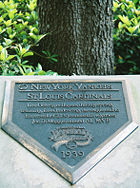
At the midpoint of the 1938 season, Gehrig's performance began to diminish. At the end of that season, he said, "I tired mid season. I don't know why, but I just couldn't get going again." Although his final 1938 stats were respectable (.295 batting average, 114 RBI, 170 hits, .523 slugging percentage, 689 plate appearances with only 75 strikeouts, and 29 home runs), it was a dramatic drop from his 1937 season (when he batted .351 and slugged .643). In the 1938 post-season his batting average was .286 and all four of his hits were singles.[28]
When the Yankees began their 1939 spring training in St. Petersburg, Florida, it was obvious that Gehrig no longer possessed his once-formidable power. Even Gehrig's base running was affected, and at one point he collapsed at Al Lang Field, the Yankees' spring training park at the time in St. Petersburg.[29] By the end of spring training, Gehrig had not hit even one home run.[30] Throughout his career, Gehrig was considered an excellent runner on the basepaths, but as the 1939 season got underway, his coordination and speed had deteriorated significantly.[31]
By the end of April, his statistics were the worst of his career, with just 1 RBI and a .143 batting average. Fans and the press openly speculated on Gehrig's abrupt decline. James Kahn, a reporter who wrote often about Gehrig, said in one article:
I think there is something wrong with him. Physically wrong, I mean. I don't know what it is, but I am satisfied that it goes far beyond his ball-playing. I have seen ballplayers 'go' overnight, as Gehrig seems to have done. But they were simply washed up as ballplayers. It's something deeper than that in this case, though. I have watched him very closely and this is what I have seen: I have seen him time a ball perfectly, swing on it as hard as he can, meet it squarely — and drive a soft, looping fly over the infield. In other words, for some reason that I do not know, his old power isn't there... He is meeting the ball, time after time, and it isn't going anywhere.[32]
He was indeed meeting the ball, with only one strikeout in 28 at-bats. But Joe McCarthy found himself resisting pressure from Yankee management to switch Gehrig to a part-time role. Things came to a head when Gehrig had to struggle to make a routine put-out at first base. The pitcher, Johnny Murphy, had to wait for Gehrig to drag himself over to the bag so he could catch Murphy's throw. Murphy said, "Nice play, Lou."[32]
On April 30, Gehrig went hitless against the weak Washington Senators. Gehrig had just played his 2,130th consecutive Major League game.[21]
On May 2, the next game after a day off, Gehrig approached McCarthy before the game in Detroit against the Tigers and said, "I'm benching myself, Joe", telling the Yankees' skipper that he was doing so "for the good of the team".[33] McCarthy acquiesced and put Ellsworth "Babe" Dahlgren in at first base, and also said that whenever Gehrig wanted to play again, the position was his. Gehrig himself took the lineup card out to the shocked umpires before the game, ending the 14-year stamina streak. Before the game began, the Briggs Stadium announcer told the fans, "Ladies and gentlemen, this is the first time Lou Gehrig's name will not appear on the Yankee lineup in 2,130 consecutive games." The Detroit Tigers fans gave Gehrig a standing ovation while he sat on the bench with tears in his eyes.[28] Gehrig stayed with the Yankees as team captain for a few more weeks, but he never played baseball again.[28]
Diagnosis
As Lou Gehrig's debilitation became steadily worse, Eleanor called the famed Mayo Clinic in Rochester, Minnesota. Her call was transferred to Dr. Charles William Mayo, who had been following Gehrig's career and his mysterious loss of strength. Dr. Mayo told Eleanor to bring Gehrig as soon as possible.[28]
Eleanor and Gehrig flew to Rochester from Chicago, where the Yankees were playing at the time, arriving at the Mayo Clinic on June 13, 1939. After six days of extensive testing at Mayo Clinic, the diagnosis of amyotrophic lateral sclerosis (ALS) was confirmed on June 19, Gehrig's 36th birthday.[34] The prognosis was grim: rapidly increasing paralysis, difficulty in swallowing and speaking, and a life expectancy of fewer than three years, although there would be no impairment of mental functions. Eleanor Gehrig was told that the cause of ALS was unknown but it was painless, non-contagious and cruel — the central nervous system is destroyed but the mind remains fully aware to the end.[35][36]
Gehrig often wrote letters to Eleanor, and in one such note written shortly afterwards, said (in part):
The bad news is lateral sclerosis, in our language chronic infantile paralysis. There isn't any cure... there are very few of these cases. It is probably caused by some germ...Never heard of transmitting it to mates... There is a 50-50 chance of keeping me as I am. I may need a cane in 10 or 15 years. Playing is out of the question...[37]
Following Gehrig's visit to the Mayo Clinic, he briefly rejoined the Yankees in Washington, DC. As his train pulled into Union Station, he was greeted by a group of Boy Scouts, happily waving and wishing him luck. Gehrig waved back, but he leaned forward to his companion, a reporter, and said, "They're wishing me luck — and I'm dying."[34]
"The Luckiest Man on the Face of the Earth"
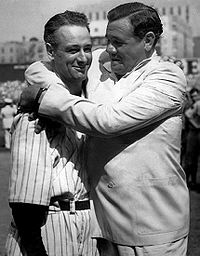
On June 21, the New York Yankees announced Gehrig's retirement and proclaimed July 4, 1939, "Lou Gehrig Appreciation Day" at Yankee Stadium. Between games of the Independence Day doubleheader against the Washington Senators, the poignant ceremonies were held on the diamond. In its coverage the following day, The New York Times said it was "Perhaps as colorful and dramatic a pageant as ever was enacted on a baseball field [as] 61,808 fans thundered a hail and farewell".[38] Dignitaries extolled the dying slugger and the members of the 1927 Yankees World Championship team, known as "Murderer's Row", attended the ceremonies. New York Mayor Fiorello La Guardia called Gehrig "the greatest prototype of good sportsmanship and citizenship" and Postmaster General James Farley concluded his speech by predicting, "For generations to come, boys who play baseball will point with pride to your record."[38]
Yankees Manager Joe McCarthy, struggling to control his emotions, then spoke of Lou Gehrig, with whom there was a close, almost father and son-like bond. After describing Gehrig as "the finest example of a ballplayer, sportsman, and citizen that baseball has ever known", McCarthy could stand it no longer. Turning tearfully to Gehrig, the manager said, "Lou, what else can I say except that it was a sad day in the life of everybody who knew you when you came into my hotel room that day in Detroit and told me you were quitting as a ballplayer because you felt yourself a hindrance to the team. My God, man, you were never that."[39]
The Yankees retired Gehrig's uniform number "4", making him the first player in Major League Baseball history to be accorded that honor.[40] Gehrig was given many gifts, commemorative plaques, and trophies. Some came from VIPs; others came from the stadium's groundskeepers and janitorial staff. Footage of the ceremonies shows Gehrig being handed various gifts, and immediately setting them down on the ground, because he no longer had the arm strength to hold them.[34] The Yankees gave him a silver trophy with their signatures engraved on it. Inscribed on the front was a special poem written by The New York Times writer John Kieran.[41] The trophy cost only about $5, but it became one of Gehrig's most prized possessions.[42] It is currently on display at the Baseball Hall of Fame.
After the presentations and remarks by Babe Ruth, Gehrig addressed the crowd:
| "Fans, for the past two weeks you have been reading about the bad break I got. Yet today I consider myself the luckiest man on the face of the earth. I have been in ballparks for seventeen years and have never received anything but kindness and encouragement from you fans.
"Look at these grand men. Which of you wouldn’t consider it the highlight of his career just to associate with them for even one day? Sure, I’m lucky. Who wouldn’t consider it an honor to have known Jacob Ruppert? Also, the builder of baseball’s greatest empire, Ed Barrow? To have spent six years with that wonderful little fellow, Miller Huggins? Then to have spent the next nine years with that outstanding leader, that smart student of psychology, the best manager in baseball today, Joe McCarthy? Sure, I'm lucky. "When the New York Giants, a team you would give your right arm to beat, and vice versa, sends you a gift — that’s something. When everybody down to the groundskeepers and those boys in white coats remember you with trophies — that’s something. When you have a wonderful mother-in-law who takes sides with you in squabbles with her own daughter — that's something. When you have a father and a mother who work all their lives so that you can have an education and build your body — it's a blessing. When you have a wife who has been a tower of strength and shown more courage than you dreamed existed — that's the finest I know. "So I close in saying that I might have been given a bad break, but I've got an awful lot to live for. Thank you." |
|
|
|
|
The crowd stood and applauded for almost two minutes. Gehrig was visibly shaken as he stepped away from the microphone, and wiped the tears away from his face with his handkerchief.[42] Babe Ruth came over and hugged him as a band played "I Love You Truly" and the crowd chanted "We love you, Lou". The New York Times account the following day called it "one of the most touching scenes ever witnessed on a ball field", that made even hard-boiled reporters "swallow hard".[38]
In December 1939, Lou Gehrig was elected unanimously to the National Baseball Hall of Fame in a special election by the Baseball Writers Association, waiving the waiting period normally required after a ballplayer's retirement.[44] At age 36, he was the youngest player to be so honored.[45]
Final years
"Don't think I am depressed or pessimistic about my condition at present," Lou Gehrig wrote following his retirement from baseball. Struggling against his ever-worsening physical condition, he added, "I intend to hold on as long as possible and then if the inevitable comes, I will accept it philosophically and hope for the best. That's all we can do."[34]
In October 1939, he accepted Mayor LaGuardia's appointment to a ten-year term as a New York City Parole Commissioner and was sworn into office on January 2, 1940.[46] The Parole Commission commended the ex-ballplayer for his "firm belief in parole, properly administered", stating that Gehrig "indicated he accepted the parole post because it represented an opportunity for public service. He had rejected other job offers – including lucrative speaking and guest appearance opportunities – worth far more financially than the $5,700 a year commissionership." Gehrig visited New York City's correctional facilities, but insisted that they not be covered by news media.[47] Gehrig, as always, quietly and efficiently performed his duties. He was often helped by his wife Eleanor, who would guide his hand when he had to sign official documents. About a month before his death, when Gehrig reached the point where his deteriorating physical condition made it impossible for him to continue in the job, he quietly resigned.[48]
On June 2, 1941, at 10:10 p.m., sixteen years to the day after he replaced Wally Pipp at first base, Henry Louis Gehrig died at his home at 5204 Delafield Avenue, in the Fieldston section of the Bronx, New York.[49][50]
Upon hearing the news, Babe Ruth and his wife Claire went to the Gehrig house to console Eleanor. Mayor LaGuardia ordered flags in New York to be flown at half-staff, and Major League ballparks around the nation did likewise.[51]
Following the funeral at Christ Episcopal Church of Riverdale, Gehrig's remains were cremated and interred on June 4 at Kensico Cemetery in Valhalla, New York. Lou Gehrig and Ed Barrow are both interred in the same section of Kensico Cemetery, which is next door to Gate of Heaven Cemetery, where the graves of Babe Ruth and Billy Martin are located.[52]
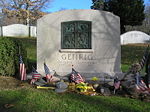
Eleanor Gehrig never remarried following her husband's passing, dedicating the rest of her life to supporting ALS research.[14] She died on March 6, 1984, on her 80th birthday. They had no children.
The Yankees dedicated a monument to Gehrig in center field at Yankee Stadium on July 6, 1941, the shrine lauding him as, "A man, a gentleman and a great ballplayer whose amazing record of 2,130 consecutive games should stand for all time." Gehrig's monument joined the one placed there in 1932 to Miller Huggins, which would eventually be followed by Babe Ruth's in 1949.[21]
Gehrig's birthplace in Manhattan, 1994 Second Avenue (near E. 103rd Street), is memorialized with a plaque marking the site. Another early residence on E. 94th Street (near Second Avenue) is noted with a plaque. The Gehrigs' white house at 5204 Delafield Avenue in the Riverdale section of the Bronx, where Lou Gehrig died, still stands today on the east side of the Henry Hudson Parkway and is likewise marked by a plaque.[16]
Accomplishments: records, awards, and distinctions
Sixty years after his farewell to baseball, Gehrig received the most votes of any baseball player on the Major League Baseball All-Century Team, chosen by fans in 1999.[4]
| Accomplishment | Record |
|---|---|
| Grand Slams | 23 |
| Runs batted in (RBI) by a First Baseman | 1,995 |
| Consecutive seasons, 120+ RBIs | 8 (1927–1934) |
| Runs scored by a first baseman | 1,888 |
| Highest on-base percentage by a first baseman | .447 |
| Most bases on balls by a first baseman | 1,508 |
| Highest slugging percentage by a first baseman | .632 |
| Most extra base hits by a first baseman | 1190 |
| Accomplishment | Record |
|---|---|
| Runs-batted-in by a first baseman | 184 (1931) |
| Runs scored by a first baseman | 167 (1936) |
| Highest slugging percentage by a first baseman | .765 (1927) |
| Extra Base Hits, by a first baseman | 117 (1927) |
| Most total bases by a first baseman | 447 (1927) |
| Accomplishment | Record |
|---|---|
| Home Runs | 4[54] |
| Award | Year |
|---|---|
| Inducted into National Baseball Hall of Fame | 1939 |
| American League MVP | 1927, 1936 (runner-up in 1931 and 1932) |
| Named to seven All-Star teams | (1933–1939); played in six (retired before 1939 All-Star Game) |
| Named starting first baseman on the Major League Baseball All-Century Team[4] | 1999 |
| The Lou Gehrig Memorial Award | Unavailable[55] |
Other distinctions
| Accomplishment | Year | ||||
|---|---|---|---|---|---|
| Triple Crown (.363 BA, 49 HR, 165 RBI) | 1934 | ||||
| Only player in history to collect 400 total bases in five seasons | 1927, 1930, 1931, 1934, 1936 | ||||
| With Stan Musial, one of two players to collect at least 500 doubles, 150 triples, and 400 home runs in a career | – | ||||
| One of only six players (Babe Ruth, Jimmie Foxx, Joe DiMaggio, Stan Musial, and Ted Williams were the others) to end their career with a minimum .320 batting average, 350 home runs, and 1,500 RBI. | – | ||||
| Only player to hit 40 doubles and 40 home runs in the same season non-consecutively | 1927, 1930, 1934 | ||||
| Scored game-winning run in 8 World Series games | – | ||||
| First athlete ever to appear on a box of Wheaties | – | ||||
| First baseball player to have his uniform number retired July 4, 1939 farewell speech was voted by fans as the fifth greatest moment in Major League Baseball history in 2002 | July 4, 1939 | ||||
| A Lou Gehrig 25-cent USA Postage Stamp was issued by the U.S. Postal Service (Scott number 2417) |
1989 | ||||
| Gehrig was mentioned in the poem "Lineup for Yesterday" by Ogden Nash: | |||||
|
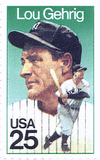 |
||||
Film and other media
Lou Gehrig starred in the 1938 20th Century Fox movie Rawhide playing himself in his only feature film appearance.[57] In 2006, researchers presented a paper to the American Academy of Neurology, reporting on an analysis of Rawhide and photographs of Lou Gehrig from the 1937–1939 period, to ascertain when Gehrig began to show visible symptoms of amyotrophic lateral sclerosis. They concluded that while atrophy of hand muscles could be detected in 1939 photographs of Gehrig, no such abnormality was visible at the time Rawhide was made in January 1938. "Examination of Rawhide showed that Gehrig functioned normally in January 1938", the report concluded.[58]
In 1942, the life of Lou Gehrig was portrayed in the movie The Pride of the Yankees, starring Gary Cooper as Gehrig and Teresa Wright as his wife Eleanor. It received 11 Academy Award nominations and won in one category, Film Editing. Real-life Yankees Babe Ruth, Bob Meusel, Mark Koenig and Bill Dickey (then still an active player) played themselves, as did sportscaster Bill Stern.
Later, in 1978, a TV movie, A Love Affair: The Eleanor and Lou Gehrig Story was released, starring Blythe Danner and Edward Herrmann as Eleanor and Lou Gehrig, respectively. It was based on the 1976 autobiography My Luke and I, written by Eleanor Gehrig and Joseph Durso.
In an episode of the PBS series Jean Shepherd's America, the Chicago-born storyteller told of how he and his father (Jean Shepherd, Sr.) would watch Chicago White Sox games from the right field upper deck at Comiskey Park in the 1930s. On one occasion, the Sox were playing the Yankees, and Shepherd Sr. had been taunting Gehrig, yelling at him all day. In the top of the ninth, with Sox icon Ted Lyons holding a slim lead, Gehrig came up with a man on base, and the senior Shepherd yelled in a voice that echoed around the ballpark, "Hit one up here, ya bum! I dare ya!" Gehrig did exactly that, hitting a screaming liner, practically into the heckler's lap, for the eventual game-winning home run. Shepherd's father was booed mercilessly, and he never again took junior Jean to a game. He apparently told this story originally when Gehrig's widow was in the audience at a speaking engagement.[59]
See also
|
|
|
Notes
- ↑ 1.0 1.1 "Lou Gehrig". Britannica Encyclopedia. Retrieved on 2008-04-16.
- ↑ "Lou Gehrig Grand Slams". Baseball Almanac. Retrieved on 2008-04-16.
- ↑ Frank Graham, Lou Gehrig: A Quiet Hero. Boston: Houghton Mifflin, 1969.
- ↑ 4.0 4.1 4.2 "All-Century Team final voting". ESPN (2007-10-23). Retrieved on 2008-06-02.
- ↑ "Amyotrophic Lateral Sclerosis (ALS)". Muscular Dystrophy Association (MDA). Retrieved on 2008-04-16.
- ↑ "All-Star Game History". Baseball Almanac (2007). Retrieved on 2007-07-04.
- ↑ 7.0 7.1 "White House Dream Team: Lou Gehrig". whitehouse.gov. Retrieved on 2008-04-16.
- ↑ 8.0 8.1 Robinson, Ray (1990). Iron Horse: Lou Gehrig in His Time. New York: W.W. Norton. pp. 30–31. ISBN 0393028577.
- ↑ Robinson, Iron Horse: Lou Gehrig in His Time, p. 44.
- ↑ "P.S. 132 Historical Perspective". NYC Department of Education. Retrieved on 2008-04-16.
- ↑ World Book Encyclopedia, Chicago: Field Enterprises, 1958, p. 2897.
- ↑ 12.0 12.1 12.2 Robinson, Ray. "Lou Gehrig: Columbia Legend and American Hero". Retrieved on 2008-04-16.
- ↑ 13.0 13.1 "Commerce Team Wins", The New York Times (June 27, 1920).
- ↑ 14.0 14.1 William Kashatus, Lou Gehrig: A Biography. Westport CT: Greenwood Press, 2004.
- ↑ Robinson, Iron Horse: Lou Gehrig in His Time, pp. 58–59.
- ↑ 16.0 16.1 16.2 16.3 16.4 16.5 16.6 "Lou Gehrig: Biography". lougehrig.com. Retrieved on 2008-04-16.
- ↑ Kashatus, William (2004). Lou Gehrig: A Biography (Baseball's All-Time Greatest Hitters) (Hardcover). Greenwood Press. ISBN 0313328668.
- ↑ "Murderers' Row and Beyond". Baseball Almanac. Retrieved on 2008-04-18.
- ↑ "MVP BAseball Players". Baseball Reference. Retrieved on 2008-04-18.
- ↑ 20.0 20.1 Newman, Mark. "Gehrig's shining legacy of courage". MLB.com. Retrieved on 2008-04-18.
- ↑ 21.0 21.1 21.2 "Lou Gehrig". The Idea Logical Company, Inc.. Retrieved on 2008-04-18.
- ↑ "Box Score of Four Home Run Game by Lou Gehrig". Baseball Almanac (2000). Retrieved on 2008-08-05.
- ↑ Baseball's Unforgettable Games (1960, by Joe Reichler and Ben Olan
- ↑ "Equinoctial Climax", Time magazine (October 5, 1936). Retrieved on 2007-12-17.
- ↑ Davis, J.H. (1988). "Fixing the Standard of Care: Motivated Athletes and Medical Malpractice". American Journal of Trial Advocacy 12: 215. http://scholar.google.com/scholar?hl=en&lr=&q=info:tFte_3bGN7AJ:scholar.google.com/&output=viewport. Retrieved on 2008-04-17.
- ↑ (– Scholar search)Mike Tilden English 15 Gregg Rogers 10/24/2002 September 11 Defines “American Hero”. http://www.personal.psu.edu/users/m/w/mwt131/frosh/engl015/definition%20paper.pdf. Retrieved on 2008-04-17.
- ↑ Greenberg, D.A.; Jin, K. (2004). "VEGF and ALS: the luckiest growth factor?". Trends in Molecular Medicine 10 (1): 1–3. doi:.
- ↑ 28.0 28.1 28.2 28.3 Malik, N. (2000). "Lou Gehrig's Disease: A Closer Look at the Genetic Basis of Amyotrophic Lateral Sclerosis" (– Scholar search). Pediatrics 3 (3). http://www.geriatricsandaging.com/FMPro?-DB=GA_articles_database&-Find=&-Format=record_detail.htm&Name=Lou%20Gehrig's%20Disease:%20A%20Closer%20Look%20at%20the%20Genetic%20Basis%20of%20Amyotrophic%20Lateral%20Sclerosis. Retrieved on 2008-04-17.
- ↑ Bob Chick (2008-02-24). "Spring Training In St. Petersburg — The Final Out", The Tampa Tribune.
- ↑ Robinson, Iron Horse: Lou Gehrig in His Time, p. 248.
- ↑ Walling, A.D. (1999). "Amyotrophic lateral sclerosis: Lou Gehrig's disease.". Am Fam Physician 59 (6): 1489–96. http://www.ncbi.nlm.nih.gov/sites/entrez?db=pubmed&uid=99207934&cmd=showdetailview&indexed=google. Retrieved on 2008-04-17.
- ↑ 32.0 32.1 "Quotes about Lou Gehrig". lougehrig.com. Retrieved on 2008-04-16.
- ↑ Robinson, Iron Horse: Lou Gehrig in His Time, pp. 251–253.
- ↑ 34.0 34.1 34.2 34.3 Eig, Jonathan (2005). Luckiest Man: The Life and Death of Lou Gehrig. New York: Simon & Schuster. ISBN 0743245911.
- ↑ Robinson, Iron Horse: Lou Gehrig in His Time, p. 258.
- ↑ Cardoso, R.M.F.; Thayer, M.M.; Didonato, M.; Lo, T.P.; Bruns, C.K.; Getzoff, E.D.; Tainer, J.A. (2002). "Insights into Lou Gehrig's Disease from the Structure and Instability of the A4V Mutant of Human Cu, Zn Superoxide Dismutase". Journal of Molecular Biology 324 (2): 247–256. doi:.
- ↑ Kaden, S. (2002). "More About His ALS Battle". Retrieved on 2008-04-16.
- ↑ 38.0 38.1 38.2 John Drebinger, "61,808 Fans Roar Tribute to Gehrig", The New York Times, July 5, 1939.
- ↑ Belli, R.F.; Schuman, H. (1996). "The complexity of ignorance". Qualitative Sociology 19 (3): 423–430. doi:. http://www.springerlink.com/index/2X76864U72372M35.pdf. Retrieved on 2008-04-17.
- ↑ Greenberger, R. (2003). Lou Gehrig. The Rosen Publishing Group.
- ↑ The inscription on the trophy presented to Gehrig from his Yankees teammates:
Source: The Day He Retired, S. Kaden, 2003
"We've been to the wars together;
We took our foes as they came;
And always you were the leader,
And ever you played the game.
Idol of cheering millions,
Records are yours by sheaves;
Iron of frame they hailed you
Decked you with laurel leaves.
But higher than that we hold you,
We who have known you best;
Knowing the way you came through
Every human test.
Let this be a silent token
Of lasting Friendship's gleam,
And all that we've left unspoken;
Your Pals of the Yankees Team." - ↑ 42.0 42.1 The Day He Retired, S. Kaden, 2003
- ↑ "Farewell Speech". lougehrig.com (July 4, 1939). Retrieved on 2008-04-16.
- ↑ Robinson, Iron Horse: Lou Gehrig in His Time, p. 266.
- ↑ "Henry Louis Gehrig". National Baseball Hall of Fame and Museum, Inc.. National Baseball Hall of Fame and Museum, Inc.. Retrieved on 2008-04-18.
- ↑ Robinson, Iron Horse: Lou Gehrig in His Time, p. 266.
- ↑ In appointing Gehrig as a Parole Commissioner, Mayor LaGuardia said, "I believe he will be not only a capable, intelligent commissioner but that he will be an inspiration and a hope to many of the younger boys who have gotten into trouble. Surely the misfortune of some of the young men will compare as something trivial with what Mr. Gehrig has so cheerfully and courageously faced." Gehrig continued to go regularly to his City Hall office until a month before his death. (reference: New York City Parole Commission history)
- ↑ Cleveland, D.W.; Rothstein, J.D. (2001). "From Charcot to Lou Gehrig: deciphering selective motor neuron death in ALS". Nat Rev Neurosci 2 (11): 806–19. doi:. http://www.lifesci.sussex.ac.uk/teaching/C7101/From_Charcot_to_Lou_g.pdf. Retrieved on 2008-04-17.
- ↑ "Gehrig, 'Iron Man' of Baseball, Dies at the age of 37", The New York Times, June 3, 1941.
- ↑ Yardley, Jonathan. "Book World Live: Luckiest Man: The Life and Death of Lou Gehrig", The Washington Post, April 5, 2005. Accessed May 3, 2008. "On June 2, 1941, just days short of his 38th birthday, Henry Louis Gehrig died at his house in the pleasant New York City neighborhood of Riverdale."
- ↑ Time magazine, June 16, 1941.
- ↑ Innes, A.M.; Chudley, A.E. (1999). "Genetic landmarks through philately- Henry Louis'Lou' Gehrig and amyotrophic lateral sclerosis". Clinical Genetics 56 (6): 425–427. doi:.
- ↑ 53.0 53.1 53.2 53.3 53.4 "Achievements". lougehrig.com. Retrieved on 2008-04-16.
- ↑ The record is held with 14 other players
- ↑ The Lou Gehrig Memorial Award was created by the Phi Delta Theta fraternity in his honor and is given to players who best exemplify Gehrig's character and integrity both on and off the field. Since the award was created in 1955, the name of each winner has been placed on the Lou Gehrig Award plaque in the Baseball Hall of Fame in Cooperstown, New York.
- ↑ "Line-Up For Yesterday by Ogden Nash". Baseball Almanac. Retrieved on 2008-01-23.
- ↑ Robinson, Iron Horse: Lou Gehrig in His Time, pp. 231–232.
- ↑ "Lou Gehrig, Rawhide, and 1938". American Academy of Neurology (2006-07-13). Retrieved on 2008-04-22.
- ↑ Partridge, Ernest. "Jean Shepherd -- 1921-1999". Retrieved on 2008-04-16.
External links
- Baseball Hall of Fame – Member biography
- Career statistics and player information from Baseball-Reference, or Fangraphs, or The Baseball Cube
- Video, Audio and Text of Lou Gehrig's Farewell to Baseball Address
- Official Website
- Gehrig's shining legacy of courage, Major League Baseball tribute by Mark Newman on Gehrig's 100th birthday.
- The Luckiest Man On The Earth, song about Lou Gehrig
- Lou Gehrig Memorial at Find A Grave
| Accomplishments | |||||||||||||||||||||
|---|---|---|---|---|---|---|---|---|---|---|---|---|---|---|---|---|---|---|---|---|---|
|
|
|||||||||||
|
|||||
|
|||||
|
|||||
|
|||||
|
|||||
|
|||||
|
|||||
|
|||||
|
|||||
|
||||||||
|
|||||
| Ivy League Major League Baseball All-Stars | ||||||
|---|---|---|---|---|---|---|
| Player | Lou Gehrig | Red Rolfe | Ron Darling | Brad Ausmus | Mike Remlinger | Chris Young |
| School | Columbia University | Dartmouth College | Yale University | Dartmouth College | Dartmouth College | Princeton University |
| Team | New York Yankees | New York Yankees | New York Mets | Detroit Tigers | Atlanta Braves | San Diego Padres |
| All-Star teams | 1933–1939 | 1937–1940 | 1985 | 1999 | 2002 | 2007 |
| Persondata | |
|---|---|
| NAME | Gehrig, Henry Louis |
| ALTERNATIVE NAMES | Gehrig, Ludwig Heinrich, The Iron Horse |
| SHORT DESCRIPTION | Professional baseball player |
| DATE OF BIRTH | June 19, 1903 |
| PLACE OF BIRTH | New York, New York |
| DATE OF DEATH | June 2, 1941 |
| PLACE OF DEATH | Riverdale, Bronx, New York |